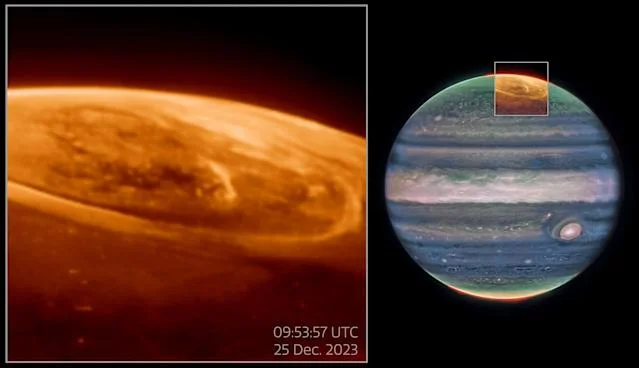
James Webb Telescope Unveils ‘Impossible’ Auroras on Jupiter, Baffling Scientists
The James Webb Space Telescope (JWST) has captured stunning images and videos of auroras on Jupiter, revealing details so unexpected that they've left scientists scratching their heads. These aren't your average Northern Lights; Jupiter's auroras are hundreds of times brighter and more energetic than those on Earth, presenting a cosmic puzzle that researchers are eager to solve.

On Christmas Day 2023, JWST trained its infrared cameras on Jupiter's auroras, witnessing a dazzling light show that has since been detailed in a May 12th publication in Nature Communications. Jonathan Nichols, a researcher at the University of Leicester, exclaimed, "What a Christmas present it was – it just blew me away!" His team initially anticipated gradual changes in the auroras, but instead, they observed a dynamic spectacle, "fizzing and popping with light, sometimes varying by the second."
Auroras occur when high-energy charged particles collide with gases in a planet's atmosphere. In Jupiter's case, its powerful magnetic field scoops up particles from the solar wind and from volcanic eruptions on its moon Io, accelerating them toward the poles, creating auroras far brighter than Earth's.
Webb's sensitivity allowed astronomers to focus on the trihydrogen cation (H3+), a molecule formed in Jupiter's auroras. Its infrared emission helps cool Jupiter’s atmosphere, but can also be destroyed, meaning scientists are working to understand quantity and timeline. The team discovered the H3+ emissions varied more than expected, lasting only about two and a half minutes before disappearing. This finding could help refine our understanding of Jupiter's atmospheric cooling processes.

However, the observations also revealed a perplexing discrepancy. Simultaneous observations from the Hubble Space Telescope, capturing ultraviolet light, didn't align with Webb's infrared data. "Bizarrely, the brightest light observed by Webb had no real counterpart in Hubble's pictures," Nichols stated. This suggests that a combination of high quantities of very low-energy particles, previously thought impossible, are impacting Jupiter’s atmosphere.
To unravel this mystery, researchers plan to integrate further JWST data with observations from NASA's Juno spacecraft, which has been orbiting Jupiter since 2016. By combining these datasets, they hope to gain a more complete understanding of the processes driving Jupiter's auroras and the planet's magnetosphere.
The unexpected findings from the James Webb Telescope highlight the complexities of Jupiter's atmosphere and challenge existing models of planetary interactions. What other secrets does Jupiter hold, and what will future observations reveal about this gas giant? Share your thoughts and theories in the comments below!